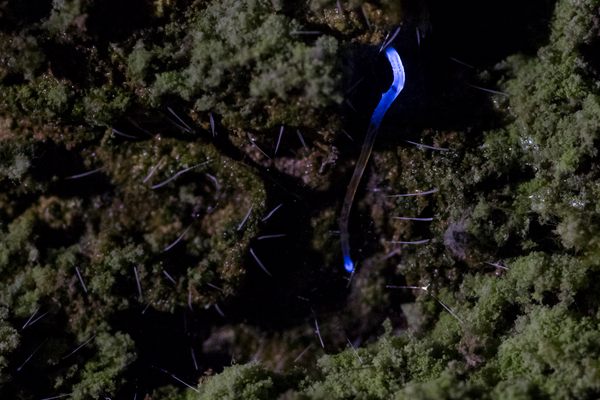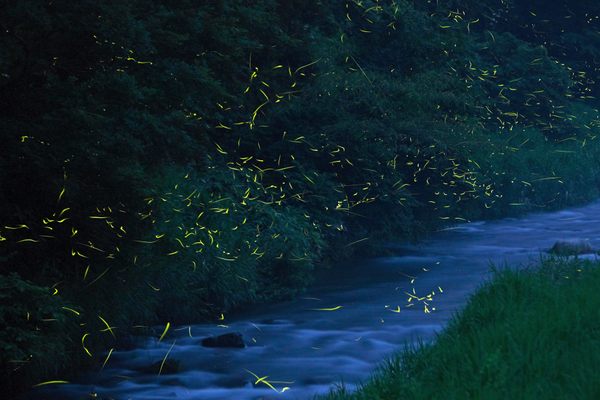Photographing Fireflies, a Love Story
An award-winning photographer shares what these bioluminescent insects have taught him—and how you can capture their beauty.
Radim Schreiber moved from the Czech Republic to Fairfield, Iowa, in 1998 with a plan to work on his English and return home after a few months. Twenty-five years later, he’s still in Iowa, because he fell in love: with his wife, Clara; with the art of photography; and with fireflies, his most frequent subject.
Two decades ago, the final project for his bachelor’s degree focused on insect portraits, and he wanted to create a close-up of a firefly against a blue sky with a full moon. The tricky lighting was beyond his camera’s capabilities at the time; back then, he wasn’t sure whether any camera was up to the task. But a few years and technological advances later, he got the shot. Meanwhile, another image from the early days of his career, “Amber Firefly,” won first prize in the Natural World category of Smithsonian Magazine’s Photo Contest in 2010.

Today, Schreiber focuses much of his work on these bioluminescent insects, including close-up macro images and landscapes, some of which are composites of thousands of different shots of meadows, forests, and other natural spaces crisscrossed with paths of ethereal firefly light.
Atlas Obscura spoke with Schreiber about his process, finding beauty in unexpected places, and how novice photographers can begin exploring the world of fireflies.
What is your process like?
I am able to do the macro photography, usually, for only about 15-20 minutes in the evening. Because I need to be able to see a firefly, approach it calmly, get close—about 10, 15 inches away—and take pictures at the moment it flashes.
Photographing the landscapes is completely different. Usually, I do it when it gets darker, which allows me to use longer exposures. I get familiar with the area and with the fireflies first. Then I come the following night knowing what I’m going to photograph and where. I leave my camera on a tripod to do long exposures, taking that one shot all night. I sometimes have three cameras running if I want to get more shots.
Photographing at night is extremely relaxing and peaceful, too, because there are no distractions. Nobody’s trying to call you. There’s no business to be done. You can just enjoy the magic and the beauty of nature. I really enjoy hanging out with fireflies.

How have fireflies changed you as a photographer?
I have never been too much of a scientific person—I’m more of an artist. But the fireflies help me to be a little more scientific and to go deeper in exploring the different subtleties and variations of the subject.
Zoning into one subject pushes me to be creative in different ways. I have to explore different settings. I have to research different fireflies and different places around the world so I can expand my horizons that way. All those interesting things about insects in general, and fireflies, help me to create a better story with my photographs. And it creates a more interesting path for me, too.
What would you say to people who think they need to travel far from home to find and photograph beauty?
There is beauty everywhere. We just need to look closer. I think everybody can find something beautiful and appealing and interesting to take photos of if they want to. Sometimes I go to the other side of the globe to photograph, and I get some great shots. But I get great shots here, too. In fact, this is where I spend the most time, and what I know best. It’s also the least expensive. Some of my award-winning photographs are pretty much from my own backyard.

Do you have any tips for people who might want to get into firefly photography, particularly if they have just a basic digital camera or smartphone?
What they need is a really good, steady tripod. They need to use manual settings, which allows them to do exposures lasting many seconds. I also use a shutter release cable. This is a little device on a cable which presses the shutter of the camera without you needing to touch it. It does two things: It keeps the camera from shaking, and it allows you to set the exposure to last more than 30 seconds. There are some [smartphone] cameras these days that have long exposure features—you can try taking a picture with an exposure of five or 10 seconds.
I come early to set up, so I can create my composition and set my depth and focus before I take the pictures. It’s much easier to do while there’s still some daylight than going around at night looking for the perfect shot.
And, of course, if somebody wants to take pictures of fireflies, it’s really useful to do it when there are many fireflies around. In the Midwest and on the East Coast, lots of fireflies are active at the end of June and the beginning of July.
[Before I became a firefly photographer], I thought it would be too difficult to chase fireflies around. Maybe I thought I would fail. [But] people should definitely take the first steps, even though there may be lots of unknowns and lots of fear. What’s holding us back is sometimes just ourselves.
This interview has been edited for clarity and length.






















Follow us on Twitter to get the latest on the world's hidden wonders.
Like us on Facebook to get the latest on the world's hidden wonders.
Follow us on Twitter Like us on Facebook